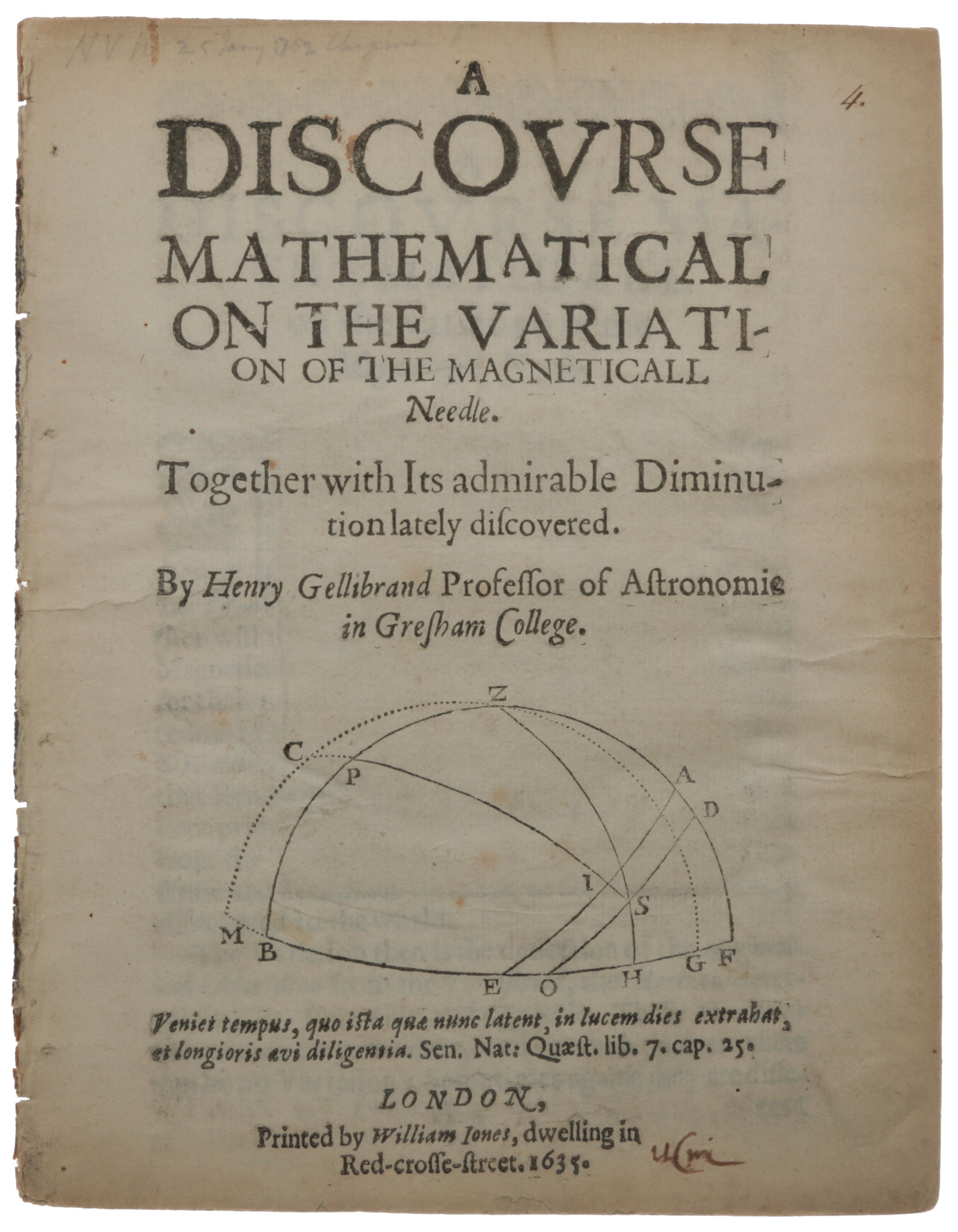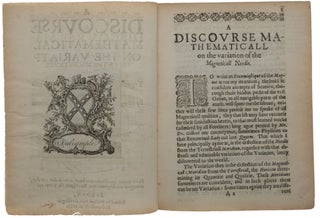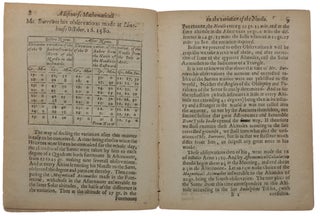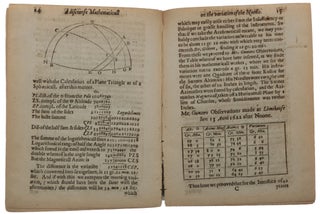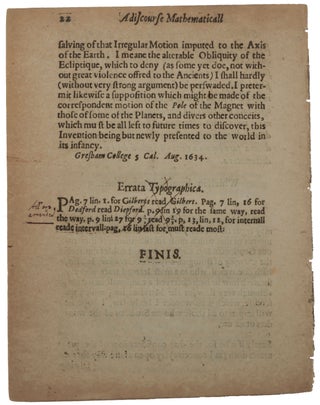A Discourse Mathematical on the Variation of the Magneticall Needle. Together with its admirable Diminution lately discovered.
London: William Jones, 1635. First edition, extremely rare, of Gellibrand’s most important discovery: the secular change in magnetic declination, or variation. According to William Gilbert in his De Magnete (1600), the existence of magnetic declination, the difference in direction between geographical and magnetic north, is a result of the magnetic effects of large land masses. This explained the observed dependence of variation on geographical location, but according to this theory the variation at a given location should not depend on historical time. Gellibrand’s great discovery, that the variation in fact changes with time, not only disproved Gilbert’s theory but was of great importance for navigation since a knowledge of the declination at various locations was used by sailors as an aid to determining their position at sea: “Thus hitherto (according to the Tenents of all our Magneticall Philosophers) we have supposed the variations of all particular places to continue one and the same. So that when a seaman shall happly returne to a place where formerly he found the same variation he may hence conclude he is in the same former longitude”. “Gellibrand’s most widely appreciated scientific discovery, which he should share with John Marr, was that of the secular change in the magnetic variation (declination). It was announced, without much comment, in A Discourse Mathematical) on the Variation of the Magneticall Needle, Together With Its Admirable Diminution Lately Discovered (1635). His predecessor, Gunter, had noticed that the variation at Limehouse in 1622 differed from the value found by William Borough in 1580, but he ascribed the difference to an error on Borough’s part. In 1633 some rough observations of his own and John Marr’s convinced Gellibrand that the value was now even less, but not until 1634 was he sufficiently confident to make a categorical assertion of its secular change. As his main evidence he referred to an appendix to Edward Wright’s Certaine Errors in Navigation… (1599, 1610). This contains a compendium of recorded values of variation at various places made by a number of physicists and navigators the world over” (DSB). Less well known is that Gellibrand, in this book, gave the first clearly documented use of the arithmetic mean as a summary statistic (see below). We have been able to trace only three copies at auction in the last 50 years: the Kenney copy (sold Sotheby’s 1968); the present copy (Sotheby’s London, 11 November, 1974, The Library of Harrison D. Horblit, Part 2, Lot 450, £1200 to Traylen); and the Streeter copy, ‘closely trimmed with loss of some headlines and shoulder notes’ (sold at Sotheby’s in 1968 and then at the Streeter sale at Christie’s New York, 2007, $21,600). All three copies were either disbound or in modern bindings. Provenance: Eighteenth-century bookplate of Lord Dalrymple on verso of title page; Harrison D. Horblit (book label inside slip case); Henry Faul, University of Pennsylvania geophysicist, d. 1981 (book label inside slip case). Henry Gellibrand was the eldest son of a physician, also Henry, and was born on 17 November 1597 in the parish of St. Botolph, Aldersgate, London. In 1615 he became a commoner at Trinity College, Oxford, and obtained a BA in 1619 and an MA in 1621. After taking holy orders he became curate at Chiddingstone, Kent, but the lectures of Sir Henry Savile inspired him to become a full-time mathematician. He settled in Oxford, where he became friends with Henry Briggs, famed for introducing logarithms to base 10. It was on Briggs’s recommendation that, on the death of Edmund Gunter, Gellibrand succeeded him as Gresham professor of Astronomy in 1627 – a post he held until his death from a fever on February 16, 1636. Gellibrand’s principal publications were concerned with mathematics (notably the completion of Briggs' Trigonometria Britannica after Briggs died in 1630) and navigation. The road to Gellibrand’s discovery starts with an observation of magnetic declination made by William Borough, a merchant seaman who rose to ‘captain general’ on the Russian trade route before becoming comptroller of the Queen's navy. The observation was made on 16 October 1580 at Limehouse, London, where he found the magnetic declination, D, to be 11.3°E. Borough had published his observations in his Variation of the Compas, which was included in Robert Norman’s New Attractive, which first appeared in 1581. Some 40 years later, Edmund Gunter, distinguished mathematician, Gresham professor of astronomy, and inventor of the slide rule, found D to be only 6.3°E. The exact date (ca. 1622) and location (probably Deptford) of the observations are not stated but it alerted Gunter to the discrepancy with Borough’s measurements. “indeed, he had been so intrigued by this discovery that he had inquired as to the exact place where, in Limehouse, William Borough had made his observations and then, with ‘a Quadrant of three foot Semidiameter, and two Needles, the one above 6 inches, and the other 10 inches long,’ had proceeded to the spot. Towards the night of 13 June 1622, he had made observations of the sun’s azimuth from several parts of the ground … The mean of these observations, 5°55’E, is less by 20’ than Gunter’s previous observations and it is almost half of Borough’s of 1580. Upon these differences, Gunter made no comment. He left it to others to draw their own conclusions” (Waters, p. 422). When Gunter dies in December 1626, he was succeeded as Gresham professor by Henry Gellibrand, who repeated Gunter’s observations at Deptford, first in June 1633 and again on the same site on June 12, 1634, the published data giving D as 4°E. On the strength of these observations he announced his discovery of secular variation in the present work. The discovery was of great significance for navigation, because measuring the variation was used to determine longitude at sea. This method had been proposed by Simon Stevin is his De Havenvinding (1599). Assuming that the worldwide distribution of variation was known, a navigator would first determine his latitude by measuring the height of the Sun above the horizon, and then search for the point along that line of latitude at which his observed value of the variation agreed with the already mapped value. This would enable him to determine his position on the line of latitude, and hence his longitude. “The discovery of ‘the secular change of variation’ was to give an added urgency to the problem of finding longitude astronomically. Not only did it show that all earlier observations of variation in all parts of the world to be thoroughly unreliable for longitude-finding, but it showed how imperative it was to check the steering compass frequently for variation, either by azimuth or amplitude observations (amplitude of the sun being the arc of the horizon between the east point and the sun when rising, or the west point and the sun when setting)” (ibid., p. 423). Gellibrand’s most popular work, Epitome of Navigation, first appeared 62 years after his death. Gellibrand himself proposed an alternative method of determining longitude based on observing various celestial events. He arranged with Captain Thomas James that they would simultaneously observe the eclipse of the moon on 29 October 1631. James was the leader of an expedition to try to find the north-west passage and at the time of the eclipse was on Charlton Island in James Bay, Canada. Gellibrand, on the other hand, was observing in Gresham College. The time difference allowed Gellibrand to compute the difference in longitude between the two points of observation and he published the results in the three-page Appendix concerning Longitude to The Strange and Dangerous Voyage of Captain Tomas James (1633). Gellibrand’s contribution to statistics was pointed out by Churchill Eisenhart in his 1971 ASA Presidential address, ‘The Development of the Concept of the Best Mean of a Set of Measurements from Antiquity to the Present Day’ (https://www.stat.uchicago.edu/~stigler/eisenhart.pdf). “Gellibrand discover[ed] the non-constancy of magnetic declination with respect to time at a given place, and incidentally provid[ed] us with the earliest explicit examples of ‘taking’ the arithmetic mean that I have come across. As a check on the accuracy of the values that Borough obtained in 1580, Gellibrand selects the particular set of observations corresponding to 20° 0’ morning and afternoon apparent altitudes of the Sun. By an astronomical computation, … he calculates the Sun’s azimuth at each of these two instants; and from Borough’s values of 45° 0’ and 20° 15’ for the angular deviations of the two shadows at these instants ‘from the North of the needle’ ‘to the westwards’ and ‘to the eastward’, respectively (p. 8), he derives a declination of 11° 0’ 0” from the morning data (p. 13), and 11° 32’ 28” from the afternoon data (p. 14), for comparison with Borough’s single value, 11° 22’ 30”. He quite clearly viewed his two values as substantiating the approximate correctness of Borough’s value; but he considered the mean of his two values as closer to the truth: ‘So that if we take the Arithmeticall meane, we may probably conclude the variation [i.e., declination] answerable to his time to be about 11 gr. 16 min.’ (p. 16). We thank Professor Stephen Stigler of the University of Chicago for pointing out to us Gellibrand’s contribution to the early history of statistics. Adams & Waters 1156; STC 11712; Taylor Mathematical Practitioners 162-3. See Malin & Bullard, ‘The direction of the Earth's magnetic field at London, 1570-1975,’ Philosophical Transactions A299, pp. 357-423; Hewson, A History of the Practice of Navigation, 1963, pp. 127, 135-6.
8vo (180 x 140mm), pp. [2], 22. Disbound, preserved in a folder and quarter morocco slipcase (lightly browned, errata corrected in an early hand, a very large copy with absolutely no cropping of headlines or side notes).
Item #5121
Price: $68,000.00

